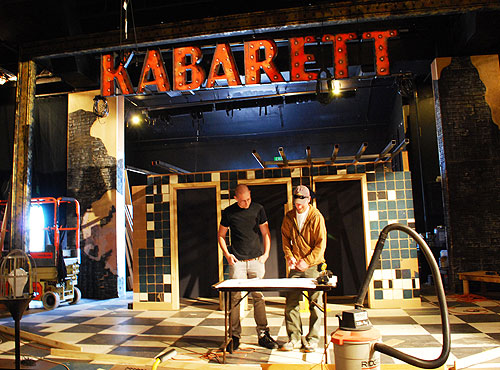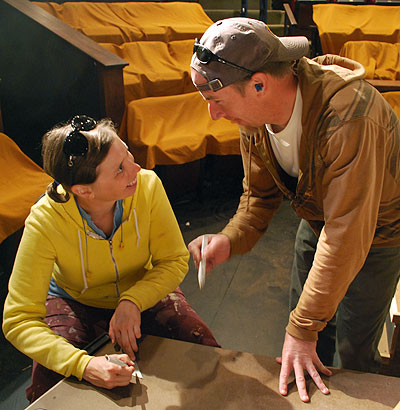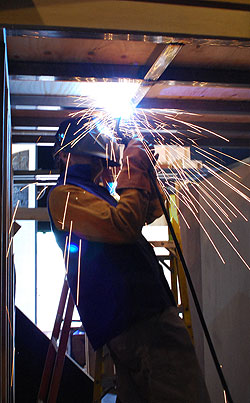The Set Design of Cabaret: Part 2
You Just Can’t Cheat!
What can I say about executing a set at the Theatre in Old Town? It’s not your everyday scene shop. As I pull up to the parking lot next to the theatre, I find myself peering over the rustic fence at the lumber racks, sawhorses, and various bits of flats from old productions. This is the shop, where the thermostat seems to vary as much as San Diego weather, and the paint takes eons to dry on a damp day, or dries too quickly in the hot sun. And the rain is a constant threat that can set us back days at a time!
 The talented team of carpenters under Technical Director Andy Scrimger use the yard behind the theatre to pre-build our scenery in parts. It’s a tricky planning process, due to a few approaches we use on our sets, which I’ll get to in a moment.
The talented team of carpenters under Technical Director Andy Scrimger use the yard behind the theatre to pre-build our scenery in parts. It’s a tricky planning process, due to a few approaches we use on our sets, which I’ll get to in a moment.
Andy began working with Cygnet in 2009, and has consistently been one to balance the needs of the budget with the demands of quality. Any technical director would tell you this is not an easy task. These days, we work together to implement strategies towards putting up a set by being very frugal, and as a byproduct (and a constant goal) using green, sustainable methods of creating scenery.
Every bit of brick or stone you’ve seen on a Cygnet set in the past several years (and trust me, there’s been a lot) is made with a recycled, pressed paper pulp product. Contrary to Vacu-form material, which is heat-molded plastic, and the mainstay of many scene shops, the recycled paper pulp actually provides us with a malleable surface of dramatic relief.
 At Cygnet, the technical director and scene designer work to plan shows in tandem with one another- finding flats from one show that can be re-covered and repainted, arranged with different elements for the next show. It is not a constraining process if one designs with these things in mind- as changing a flat, or wall unit, from three feet nine inches to four feet wide is no skin off my nose! The process becomes even more simplified when I design two shows back-to-back, as is the case with The Tragedy of the Commons and Cabaret. After all, I can pick a door casing and baseboard that works for the architectural interior of Commons, then have them gilded with gold paint for Cabaret. Shhhh. Don’t tell anyone
At Cygnet, the technical director and scene designer work to plan shows in tandem with one another- finding flats from one show that can be re-covered and repainted, arranged with different elements for the next show. It is not a constraining process if one designs with these things in mind- as changing a flat, or wall unit, from three feet nine inches to four feet wide is no skin off my nose! The process becomes even more simplified when I design two shows back-to-back, as is the case with The Tragedy of the Commons and Cabaret. After all, I can pick a door casing and baseboard that works for the architectural interior of Commons, then have them gilded with gold paint for Cabaret. Shhhh. Don’t tell anyone
Things like this really separate Cygnet from a larger theatre company. I find it unbearable to throw anything away, anticipating another show in which such an item could be used- redressed, and repainted. It’s not a hindrance to creativity- in fact it can be quite rewarding when we find a new life for an old item. And I believe it can be that personal touch, that selectiveness with consideration for keeping things, that makes some productions all the more powerful. There is a bit of magic that takes place when we can transform a chair or a table that we’ve used before, to Dakin and Macy’s patio set, or Sally Bowles’ dressing table.
 Another element added to the mix: Andy Scrimger also owns a printing company, Volume11 Graphics. He builds brochures, banners, posters, vehicle wraps, building wraps, and bus advertisements, using a variety of materials with eco-friendly methods. Due to the limits on space for painting backdrops and other similar elements, Andy has printed drops for us from digital artwork provided by designers for shows like Private Lives, Sweeney Todd, and The Tragedy of the Commons. By keeping the work in-house, there is a great deal more control on the quality and execution of these elements. And as a designer, this is exciting because I get to see my own work go directly from computer screen to full-size blowup, with fewer steps in between.
Another element added to the mix: Andy Scrimger also owns a printing company, Volume11 Graphics. He builds brochures, banners, posters, vehicle wraps, building wraps, and bus advertisements, using a variety of materials with eco-friendly methods. Due to the limits on space for painting backdrops and other similar elements, Andy has printed drops for us from digital artwork provided by designers for shows like Private Lives, Sweeney Todd, and The Tragedy of the Commons. By keeping the work in-house, there is a great deal more control on the quality and execution of these elements. And as a designer, this is exciting because I get to see my own work go directly from computer screen to full-size blowup, with fewer steps in between.
As a load-in is upon us, we find ourselves with pieces of two shows. Carpenters sort out what is to be re-used versus saved. The prefabricated elements for the next show are mixed in with the recycled elements, and the objects we saw as random pieces stacked in the scene shop take on a new life as part of a larger whole.
For any designer who’s used to seeing pieces of their set in a more complete form prior to load-in, this can be a disconcerting experience. Is it going to fit together right? Am I going to have to make an on-the-fly decision about something? Painting might happen when the pieces are in place and assembled, with some things pre-painted outside. It’s like watching a cubist sculpture become a realistic house in a matter of days.
 That is what is exciting about theatre, in the end. During load in, the cubist sculpture of elements converges to become a full-size creation of that first scale model. It distinguishes it from TV and film and many other forms of media. You just can’t cheat, or stop audiences from seeing parts of scenery. Working with real pieces in a space that is viewed from all angles, with different levels and colors of light coming from different places.
That is what is exciting about theatre, in the end. During load in, the cubist sculpture of elements converges to become a full-size creation of that first scale model. It distinguishes it from TV and film and many other forms of media. You just can’t cheat, or stop audiences from seeing parts of scenery. Working with real pieces in a space that is viewed from all angles, with different levels and colors of light coming from different places.
Once that actor steps out onto that stage in costume, all of those choices and thoughts, conversations, sketches, and droplets of paint are transformed into an environment.